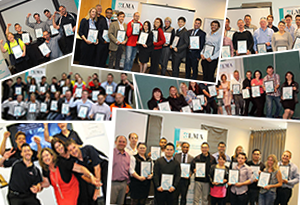We hear a lot about them in different sectors, from the social, through to the real estate market and especially in the workplace. The millennial generation, also referred to as Generation Y, is the latest emerging group of employees. Generally born between 1980 and 2000 (a disputed time line between some researchers), those belonging to this often contentious group are facing a workforce that is vastly different to their predecessors. Not only is it different because of the industries, technologies and fields that are advancing and retreating, it is different for its perception of what leadership is and how to best foster it within an upcoming workforce that is more mobile and looking for the same mobility in their work.
Within Deloitte’s latest Millennial Survey titled ‘Winning over the next generation of leaders’, the survey unearths information pivotal for anyone who is hiring millennials, working with millennials or promoting millennials.
One key element the report shines a light on is that, in general, millennials ‘express little loyalty to their current employers and many are planning near-term exits.’ Whereas previous generations followed a much more secure path from education through to long-term employment, millennials are more short-term focused, choosing their next move with what could be categorised as a ‘one foot in the door, one foot out’ type of attitude. But is it as simple as looking at millennials and categorising them as short-term workers? Or alternatively, do we all need to take a step back to look how the workplace is geared to support the growth of the next generation of potential leaders and innovators?
In a fast approaching future where millennials will represent the largest segment of the workforce, the challenge of attracting and maintaining a solid workforce has perhaps never been more difficult. As Deloitte’s survey revealed, of the nearly 7,700 millennials surveyed in 29 countries around the world, nearly a quarter of them would be looking to leave their position in a year. That figure increases to 44% when the timeframe is extended out to two years.
In terms of fostering leadership paths and leaders, these figures leave much to be desired in terms of strong retention of millennial staff. If Gen Y are to be the future leaders of both existing and not yet conceived industries, forward thinking organisations need to be strategising now about how to gain their attention and maintain it beyond the pivotal two year mark indicated by Deloitte’s research.
So, how do employers start to look at this ‘loyalty challenge’ as an opportunity to best utilise their millennial staff instead of a short coming of an entire generation of skills workers?
The report points to some confronting numbers regarding millennials, even if they have reached leadership positions. Of those surveyed, millennials in senior positions express their intention to leave their organisations relatively soon. In the current survey, approximately 1 in 5 respondents were either the head of a department or division, or have a position within the senior management team. This tells us that the issue with retention isn’t necessarily that the opportunities for advancement aren’t there, but must lie at a different origin for many millennials who are leaders in their industries.
Within our annual L.E.A.D Survey, we find that salary is still a fairly strong retention point of difference for many employers, managers and employees. However, is this translating at the same level for the upcoming millennial workforce? According to Deloitte’s research, millennials are less impressed by a business’ scale, age or its ‘buzz’ achievements. Instead, millennials are focusing more on ‘positive energy’ around a business – what does it contribute to the world, how does it align with their values, and what are they aspiring to achieve.
In short, the report points to the fact that millennials are less likely to wish to stay or lead in an organisation that doesn’t support their values or doesn’t make active choices to support them as an individual within the organisation.
Millennials want to contribute to the positive impact they believe business has on a society, but in doing so they wish to hold onto their own beliefs while achieving those of the organisation. Knowing this, current leaders can start to initiate change in their organisation to support these desires of their millennial team members and leaders
So, how can employer’s best facilitate the right environment for Gen Y to be leaders themselves? A few key suggestions may be:
- Focus on team building to foster greater loyalty
While many millennials will still feel loyalty towards an organisation, increasingly more are reporting loyalty as a result of being in a team that is productive and like-minded. There is a greater responsibility than ever for team leaders and department heads to consciously and proactively develop and maintain team cohesion. By using this to your advantage and focusing on building strong teams with enhanced interdepartmental interaction, you will be encouraging bonds to be made that are focused on group achievement and team directed innovation.
- Encourage a mentoring program amongst millennial staff
Mentoring doesn’t have to necessarily be between staff of different generations, it also has a place between millennial team members. For the mentor, the opportunity to demonstrate their values as they see them operate within the organisation will solidify their own position and reasons for remaining loyal to their team and mentee. For the mentee, they will have a light of influence to look to who can directly relate to their perspective and ideals, but can also facilitate the alignment of these values alongside those of the organisation.
- Demonstrate the organisation’s values in action
Millennials, particular those in more senior positions, are no longer just looking for that foot in the door. They are looking for purpose in their work and in the organisation they work for. Authenticity and the demonstration of this from their organisation is perhaps the greatest retention strategy for millennials in any industry. Don’t just talk the talk, walk the walk wherever and whenever you get the opportunity to.











